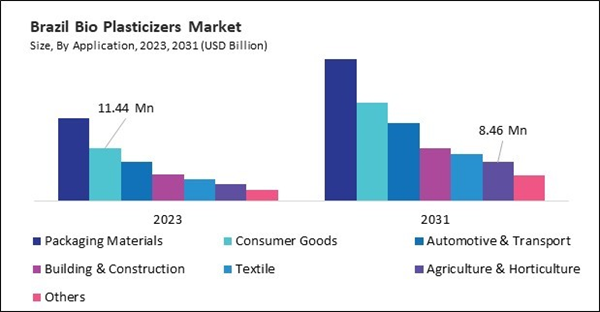Succinic acid is emerging as a promising bio plasticizer in the market due to its renewable and sustainable attributes. Derived from renewable feedstocks such as biomass, succinic acid offers an eco-friendly alternative to petroleum-based plasticizers. It is commonly used as a building block in the synthesis of various polymers and plasticizers, including succinate-based esters, which exhibit excellent plasticizing properties. In terms of volume, the consumption of Succinic acid in the Brazil Market was 5.07 Kilo Tonnes in 2023.
The Brazil market dominated the LAMEA Bio Plasticizers Market by Country in 2023 and would continue to be a dominant market till 2031; thereby, achieving a market value of $104.3 million by 2031. The Argentina market is showcasing a CAGR of 10.8% during (2024 - 2031). Additionally, The UAE market would register a CAGR of 9.3% during (2024 - 2031).
Bio plasticizers are used in the manufacturing interior components such as dashboards and door panels in the automotive industry. These bio-based materials help automakers reduce the use of fossil fuel-derived plasticizers and meet regulatory requirements for sustainable materials in vehicles. Additionally, these can improve the overall sustainability of vehicles by reducing their carbon footprint.
The construction industry is also a major consumer of these, particularly in producing PVC pipes and fittings. Bio-based plasticizers augment the flexibility and longevity of PVC products, rendering them amenable to an extensive array of construction-related applications. Contractors and builders can reduce the negative environmental effects of their projects and comply with regulatory requirements for sustainable building materials by utilizing bio plasticizers.
The rising use of these in the LAMEA region is evident in the construction industry, where sustainable practices are becoming increasingly important. In the UAE, for example, the construction industry is expected to recover significantly over the next five years, with a projected value increase of 3.7% and 4.7%, as the International Trade Administration (ITA) reported. Thus, the construction and industrial sectors in the LAMEA region are driving its rising use, reflecting a broader trend towards sustainability and environmental consciousness in the region's industries. Thus, the construction and industrial sectors in the LAMEA region are driving the rising use of bio plasticizers, reflecting a broader trend towards sustainability and environmental consciousness in the region's industries.
Based on Product, the market is segmented into Epoxidized Soyabean Oil (ESBO), Castor Oil-based Plasticizer, Citrates, Succinic Acid, and Others. Based on Application, the market is segmented into Packaging Materials, Consumer Goods, Automotive & Transport, Building & Construction, Textile, Agriculture & Horticulture, and Others. Based on countries, the market is segmented into Brazil, Argentina, UAE, Saudi Arabia, South Africa, Nigeria, and Rest of LAMEA.
List of Key Companies Profiled
- Avient Corporation
- BASF SE
- Cargill, Incorporated
- DIC Corporation
- The Dow Chemical Company
- Evonik Industries AG (RAG-Stifung)
- Lanxess AG
- Solvay SA
- ACS Technical Products
- Emery Oleochemicals LLC
Market Report Segmentation
By Product (Volume, Kilo Tonnes, USD Billion, 2020-2031)- Epoxidized Soyabean Oil (ESBO)
- Castor Oil-based Plasticizer
- Citrates
- Succinic Acid
- Others
- Packaging Materials
- Consumer Goods
- Automotive & Transport
- Building & Construction
- Textile
- Agriculture & Horticulture
- Others
- Brazil
- Argentina
- UAE
- Saudi Arabia
- South Africa
- Nigeria
- Rest of LAMEA
Table of Contents
Companies Mentioned
- Avient Corporation
- BASF SE
- Cargill, Incorporated
- DIC Corporation
- The Dow Chemical Company
- Evonik Industries AG (RAG-Stifung)
- Lanxess AG
- Solvay SA
- ACS Technical Products
- Emery Oleochemicals LLC
Methodology

LOADING...









